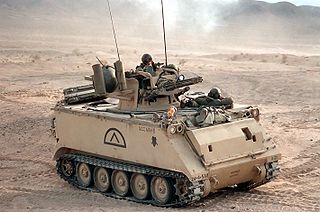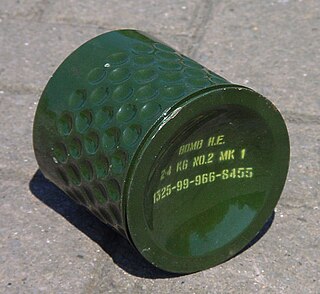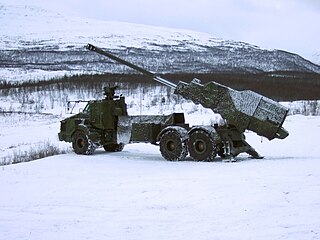
The M198 is a medium-sized, towed 155 mm artillery piece, developed for service with the United States Army and Marine Corps. It was commissioned to be a replacement for the World War II-era M114 155 mm howitzer. It was designed and prototyped at the Rock Island Arsenal in 1969 with firing tests beginning in 1970 and went into full production there in 1978. It entered service in 1979 and since then 1,600 units have been produced.
The GATOR mine system is a United States military system of air-dropped anti-tank and anti-personnel mines developed in the 1980s to be compatible with existing cluster dispensers. It is used with two dispenser systems—the Navy 230 kg (500 lb) CBU-78/B and the Air Force 450 kg (1,000 lb) CBU-89/B. Additionally the mines are used with the land- and helicopter-based Volcano mine system.

Starstreak is a British short-range surface-to-air missile that can be used as a man-portable air-defence system (MANPADS) or used in heavier systems. It is manufactured by Thales Air Defence in Belfast, Northern Ireland. It is also known as Starstreak HVM. After launch, the missile accelerates to more than Mach 4, making it the fastest short-range surface-to-air missile in existence. It then launches three laser beam-riding submunitions, increasing the likelihood of a successful hit on the target. Starstreak has been in service with the British Army since 1997. In 2012 Thales relaunched the system as ForceSHIELD.
A self-destruct is a mechanism that can cause an object to destroy itself or render itself inoperable after a predefined set of circumstances has occurred.

The Saxon is an armoured personnel carrier used by the British Army and supplied in small numbers to various overseas organisations. It was developed by GKN Sankey from earlier projects, AT 100 IS and AT104, and was due to be replaced by the Future Rapid Effect System.

The M270 Multiple Launch Rocket System is an American-developed armored, self-propelled, multiple rocket launcher.

The FV107 Scimitar is an armoured tracked military reconnaissance vehicle formerly used by the British Army, until it was retired from active service in April 2023. It was manufactured by Alvis in Coventry. It is very similar to the FV101 Scorpion, but mounts a high-velocity 30 mm L21 RARDEN cannon instead of a 76 mm gun. It was issued to Royal Armoured Corps armoured regiments in the reconnaissance role. Each regiment originally had a close reconnaissance squadron of five troops, each containing eight FV107 Scimitars. Each Main Battle Tank Regiment also employed eight Scimitars in the close reconnaissance role.

The CBU-97 Sensor Fuzed Weapon is a United States Air Force 1,000-pound (450 kg)-class freefall Cluster Bomb Unit. It was developed and produced by Textron Defense Systems. A CBU-97 used in conjunction with the Wind Corrected Munitions Dispenser guidance tail kit is converted to a precision-guided weapon, and the combination is designated CBU-105.

The M163 Vulcan Air Defense System (VADS) is a self-propelled anti-aircraft gun (SPAAG) that was used by the United States Army. The M168 gun is a variant of the General Dynamics 20 mm (0.79 in) M61 Vulcan rotary cannon, the standard cannon in most U.S. combat aircraft since the 1960s, mounted on either an armored vehicle or a trailer.

Originally known as the LAAAS, the JP233 is a British submunition delivery system consisting of large dispenser pods carrying several hundred submunitions designed to attack runways.

The Alvis Stormer is a military armoured vehicle manufactured by the British company Alvis Vickers, now BAE Systems Land & Armaments.

The BM-27 Uragan is a self-propelled 220 mm multiple rocket launcher designed in the Soviet Union to deliver cluster munitions. The system began its service with the Soviet Army in the late 1970s, and was its first spin and fin stabilized heavy multiple rocket launcher.

The Cougar is a mine-resistant ambush-protected (MRAP) and infantry mobility vehicle structured to be resistant to landmines and improvised munitions.

The M136 Volcano Vehicle-Launched Scatterable Mine System is an automated mine delivery system developed by the United States Army in the 1980s. The system uses prepackaged mine canisters which contain multiple anti-personnel (AP) and/or anti-tank (AT) mines which are dispersed over a wide area when ejected from the canister. The system, commonly referred to as Volcano, is also used by other armies around the world.

The GEMSS mine system was a United States mine-laying system, part of the Family of Scatterable Mines used to rapidly emplace large tactical minefields in friendly territory. It consisted of two different types of dispensers, the towed M128 "Frisbee Flinger" and the auxiliary M138 "Flipper" portable mine layer, and deployed mines similar to those used in the GATOR mine system minus the aeroballistic casing. GEMSS was eventually replaced in US service by the Volcano mine system.

The HB 876 mine was an air dropped area denial weapon. It was used as part of the JP233 runway denial system and the 'Hades' variant of the BL755 cluster bomb. As a result of the anti-personnel mine ban it was withdrawn from British Royal Air Force service, and the last stockpiles of the mine were destroyed on 19 October 1999.

The AT2 mine is a scatterable anti-tank mine developed by Dynamit Nobel. It can be scattered from artillery rockets or from mine laying systems, and is in service with the British, German and Norwegian armed forces. AT2 mines were donated to Ukraine by Germany.

The Archer Artillery System, or Archer – FH77BW L52, or Artillerisystem 08, is a Swedish self-propelled howitzer system. The main piece of the system is a fully automated 155 mm L52 (52-calibre-long) gun-howitzer and a M151 Protector remote-controlled weapon station mounted on a modified 6×6 chassis of the Volvo A30D all-terrain articulated hauler. The crew and engine compartment is armoured and the cab is fitted with bullet and fragmentation-resistant windows. The system also includes an ammunition resupply vehicle, a support vehicle, BONUS submunitions and M982 Excalibur guided projectiles.

The MW-1 is a German munitions dispenser similar to the British JP233. It is designed to be carried on the Tornado IDS, although it can be carried on the F-104 Starfighter and the F-4 Phantom. The MW-1 started to be phased out after the German Government ratified the Convention on Cluster Munitions in 2009.
Family of Scatterable Mines (FASCAM) is an umbrella term for a range of systems of the armed forces of the United States, which allows a maneuver commander to rapidly place mines as a situational obstacle; as a reserve obstacle emplacement capability; and to directly attack enemy formations through disrupt, fix, turn, and block. Modern fusing, sensing, and anti-disturbance devices allow scatterable mines to defeat enemy attempts to reduce and/or clear the minefield. FASCAM mines are delivered through artillery, rocket launchers, indirect crew served weapons, special mine sowing vehicles, helicopters and aircraft. FASCAM mines utilize a random or pre-programmed self-destruct period, countermeasure hardening and anti-disturbance features. All FASCAM mines have an active life cycle and self-destruct (SD) time after their active life has expired. The duration of the active life varies from 4 hours to 15 days depending on the system.

















